This is another in a series that I am writing about Nachlaot.


Achdut Yisrael
Achdut Yisarel synagogue is located in an old orphanage complex that runs between Aggripas and Yafo streets right near the Clal building. Its entrance is on an alley called Mashiach Borochov Street. The street is named for the man whose family donated the money to establish the orphanage.
You enter the compound through an old iron gate. The building Is L shaped. One wing goes to the right as you enter perpendicular to Borochov Street. It has two floors. Oon the ground floor is a Sephardic synagogue and Achdut Yisrael is located on the second floor. Next to it is an old apartment which now houses the offices for a yeshiva that is located in the other wing of the building.
A new school is located on the ground floor of the other wing. The other two sides of the rectangular compound are enclosed by an old stone wall. There is a quad in the middle.
Achdut Yisrael was a religious wing of the Revisionist Zionist movement. It was founded in Poland in 1936. The synagogue was named for the movement when it was established on what is now Rav Kook Street, off of Yaffo Street in town. In 1947 the community moved to its current location.
Both the movement and the synagogue predated the militant organizations of the Revisionist Zionist movement. Founded in Poland by Zeev Jabotinsky, the Revisionists were separate from the Labor movements which led the pre-state de facto government of the Jewish Agency during the British mandate. The Revisionists were distinguished from the laborites, in part, by the fact that they were not socialists. Jabotinsky had criticized the other Zionist organizations for fighting for the cause of Socialism while also building a Jewish State in Israel. He felt that Zionism should take precedence over any other cause and that only after a Jewish State was founded should the Zionists concern themselves with what form of government or social structure it should have.
The Revisionists also took a more ant-British position than the Laborites and began to fight against the British much earlier than their Socialist counterparts. The Revisionists felt that the British had broken their promises and violated the League of Nations mandate for establishing a Jewish State in Israel when the British imposed restrictions on Jewish immigration into the country. Their anti-British activities deepened the rift between the Revisionists and the Socialists.
The Revisionists formed the Irgun Tzva Leumi (Etzl), Hebrew for national military organization, to resist the British and fight against Arabs. It competed with the Haganah (Defense) which was formed by the Jewish Agency to protect Jewish settlements from Arab attacks and took a more militant position visa vi the British than the Haganah did.
The Revisionists splintered during World War Two over the issue of how to fight against Nazism while also resisting the British. The Etzl chose to suspend anti British activities in order to help the British fight against their greater and common enemy, Germany. Etzl fighters even volunteered to fight with the British military.
But a small group within the movement formed the Lohmei Herut Yisrael (Freedom Fighters of Israel) or Lehi. The Lehi refused to ally with the British and continued their anti-British activities during the war. After the war both groups continued to attack British forces in Israel. Their people became known as the underground. Twelve of their fighters were captured, sentenced to death and hung by the British.
During this period Achdut Yisrael was the synagogue of Rabbi Arye Levine. Rabbi Levine would speak every Friday night and blend Torah with encouragement during the dark events of the 1940s. His message spoke to the young members of the Etzl and Lehi organizations and this attracted them to the synagogue. Rabbi Levine would visit the underground’s prisoners who were held in the jail at the Russian Compound and make sure that they all had what they needed for Shabbat. Rabbi Levine would then go to their families and bring them regards from their loved ones in prison. As a result, Achdut Yisrael became associated with theses movements.
The Etzl and Lehi eventually joined with the Haganah after Israel’s independence in May 1948. They fought together against the Arabs until the end of the war.
Today Achdut Yisrael’s second name is “Oley Hagardom” which in Hebrew loosely means those who were hung. This refers to the twelve Eztl/Lehi members who were hung by the British.
Louis Murray Lipstein, 53 years old, is from the lower East Side of Manhattan and has lived in Israel since 1971. Since 1988 he has lived in Nachlaot at the corner of Narkis and Usishkin streets.
Louis first heard of Achdut Yisrael in a newspaper article twenty five years ago. He was met warmly by the old time members, many of whom were veterans of the Etzl and Lehi, when he went to pray there the first time on A Friday night and he never looked back. Today Louis is one of the shamashim, people who take care of the synagogue’s day to day maintenance. He also reads the Torah each week and blows the shofar on Rosh Hashanah. Louis gives personal tours of the synagogue and tells its history to various groups.
The orphanage closed more than fifty years ago, but its non profit organization still exists. Its founders knew that continuing funding was need to maintain the property and to feed and cloth the children. So they invested in surrounding properties. The rents collected funded the operations of the orphanage. Some apartments were used for the teachers to live in. They wanted them to be close to the children in case of emergencies.
In 1961 the government assumed responsibility for all orphans so there ceased to be a need for orphanages.
The orphanage complex is controlled today by something called a hekdesh. A hekdesh is a non-profit foundation or fund. It is operated by a board of governors who are appointed by the Chief Rabbi. Louis feels that the Shas party has used its control of the Rabannut to divert the funds of the Hekdesh towards its institutions.


Louis Lipstein poses in front of the Aron Hakodesh
Achdut Yisrael has a Tora made of Deer skin, as opposed to the more standard cow or sheep’s skin parchment. The deer skin parchment is dark brown. It was dedicated to the two Lehi members, Eliyahu Bet-Zuri and Eliyahu Hakim, who assassinated the British Lord Moyne in Cairo in 1944. They were subsequently captured and executed. Lord Moyne was the senior British minister in charge of the Middle East at the time. The Lehi held him personally responsible for British policies which limited Jewish immigration to Israel during the Holocaust.
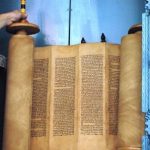

The Deer Skin Tora: Note the brown color of the parchment
During their trial, a group of Egyptian Jews commissioned the writing of the special deer skin Tora as a plea to God to save the assassins’ lives. Solomon Senior was a Canadian originally from Egypt. When Nasser took power his family fled Egypt and brought the Tora with them to Canada. In 1977 the Tora was donated to Achdut Yisrael.
The Yizkor board – a plaque with a list of names dedicated to people from the community who have died — was made in 1954. It has 498 names. It is alphabetized by first names because the people of the underground used false last names to hide their identities and so it is not clear what their last names really were.
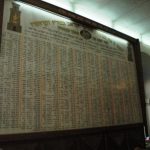

The Yizkor Board
Twenty years ago, Yehoshua Matza, a former Likud cabinet minister, arranged for the funding to renovate the interior. A new wood cover was placed over the stand where the Tora is placed during the Tora readings in the center of the synagogue. New lights were installed as well as a sculpture in the shape of a Jewish star on the front right wall dedicated to the twelve members of the underground who were executed by the British before Israel’s independence.
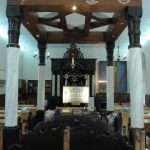

The Canopy over the table where the Tora is read. Note the various logos on it. Each was the symbol of the various groups such as the Etzl, Lehi and their parent movement Beitar


The commemorative plaque with the names of those executed by the British
The decorative wooden aron (a cabinet which sits at the front of a synagogue and houses its Tora scrolls) came from an old synagogue in Italy. There is a carved wooden bench on the Bimah with images of a dragon and serpent. During the war of independence the Arab residents of the Katamon neighborhood fled. The homes were then occupied by Arab fighters as a base for attacks on Jews. Etzl fighters fought there to clear out the neighborhood. The bench was found by some of them in a home there and they took it back to the synagogue.
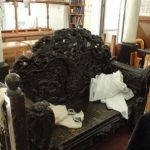

The decorative bench next to the Tora reading table
Former speaker of the Knesset, Ruby Rivlin, grew up in the community. He had his bar-mitzvah in Achdut Yisrael and held his son’s there as well.
The synagogue never had a formal membership nor did it charge for seats on Rosh Hashanah and Yom Kippur. This was in keeping with the philosophy of Rabbi Aryeh Levine. They did not want to ask people to pay for seats on the holidays and made do with private donations and the auctioning of honors such as being called to the Tora on the holidays.
That changed a few years ago when a group of younger people decided to charge for seats on the holidays. People can still attend services at the synagogue without paying or pre-ordering seats. Indeed, there are empty seats each year so space was not a reason for the change in policy. But people are asked to pay for seats and if you do then you are guaranteed a seat.
Eitan Vittelson grew up in Nachlaot and in the synagogue. He is a lawyer and currently lives with his wife and four children in Rehavia, but continues to come to pray at Achdut Yisrael. His father was Yosef Vittelson, a veteran of the Etzl underground before Israel’s independence.
Yosef Vittelson (1925-2011) was born into a Gur Hassidic family in Poland. He came to Israel with his family in 1936. As a teenager Yosef joined the “Brit Hashmonaim.” Brit Hashmonaim was the religious youth movement of Zeev Jaboinki’s Revisionist movement. Yosef joined the Revisionist Etzl organization when he was seventeen.
The British intelligence service, which coordinated the investigations into the underground groups, was based in Jerusalem’s Russian Compound. In 1945 Yosef Vittelson was one of a number of Etzl fighters who, together with the Lehi, bombed the British Intelligence headquarters in the Russian Compound. They succeeded in destroying the British’s files on the Etzel and Lehi underground movements.
Two weeks later Yosef joined a group which attacked the jail in the Russian Compound in an attempt to free members of the underground who were imprisoned there. The attack failed and Yosef was wounded. He tried to help a comrade whose wounds were more severe than his own reach a safe house in the Old City. The two wounded men were spotted while trying to cross the Jaffa Gate and were arrested by the British.
The British authorities knew that Vittelson was amember of the underground, but could not prove that he was involved in the attack. Yosef claimed that he and his friend were simply passing by the Russian Compound at the time of the explosions and that this is how they were wounded. Yosef was imprisoned at Latrun for a year before being exiled to a prison in Kenya. He was able to return to Israel in July 1948, after Israel’s independence.
When the exiles returned from Kenya there was a group of young religious people who settled in Jerusalem and became the corps of the synagogue. Yosef Vittelson first worked as a Gabbai when in prison in Kenya and continued to be the Gabbai of Achdut Yisrael for the rest of his life.


Plaque dedicated to the memory of Yosef Vittelson
“Ben Gurion did not want to recognize the contribution to independence of the undergrounds so the members felt snubbed,” explained Eitan.” “In order to honor their fallen they dedicated a plaque here in the synagogue in memory of all those who died in the fighting. Of course over the years more and more people moved from the seats here,” he said while pointing at the pews, “to the plaque on the wall (the people who passed away after independence).”
Eitan remembers Rabbi Levine. “He was a guest in our house for Shabbat meals for many years and was at my Brit. He was very important to the Etzel fighters. A week before Rabbi Levine died, my father visited him in the hospital. The Rabbi told my father to preserve the synagogue and the community. For years my father would stand outside on Friday evenings to make sure that there was a minyan (quorum).
“The neighborhood has gone through dramatic changes,” said Eitan of Nachlaot. “Once, every corner of Nachlaot was its own community where people of the same background and persuasion lived together.” But that is no longer the case.
“There is a turnover of people who come and go. It’s hard for young people to afford to buy homes in the neighborhood. Students will live here and then get married and move away.”
The young members of the community felt that if people were to pay for seats then they will definitely come to the synagogue on the holidays. They also felt that people wanted to know that they were guaranteed a place to sit. The veterans who were coming for years without paying were not required to pay for seats.
“It was specifically the young people who don’t have much money who insisted on the new policy,” explained Eitan.
Tsahi Magnay, 37, is one of those people. Tsahi is one of many people who remember Yosef Vittelson fondly. Like with many others, Tsahi was greeted warmly by Yosef when he first came tio the synagogue.
Tsahi lived in Nachlaot for eight years and got married a year ago. In that time he became a Gabbai of the synagogue. Tsahi and his pregnant wife recently moved across town. He left for the same reasons as most people. The rents in Nachlaot are too high and buying in the neighborhood is out of the question.
This past September the Vittelson family donated a new sefer Tora to the synagogue in memory of their father who passed away two years before. They held a Hachnasat Sefer Tora (bringing in of a new tora) celebration. First the sofer (scribe) completed the last few words of the Tora in Yosef Vittelson’s home. Then the family and a large number of guests danced with the Tora to the synagogue a few blocks away.


Dancing with the new Tora in the courtyard


The Sofer writes the last words of the new Tora scroll
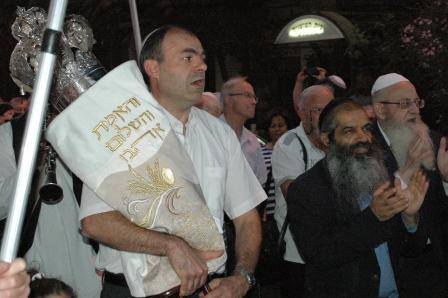

Eitan Vittelson dances with the new Tora
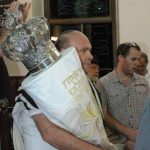

Tsahi Megnagy dances with the new Tora
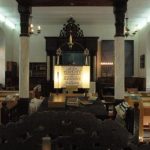

Achdut Yisrael


Plaque dedicated to Menahem Begin, the former Prime Minister of Israel who led the Ezl before independence
- On Turning 50 and Other Observations - 8/7/2020
- Pesach Movies To Watch While You Social Distance - 4/12/2020
- You vote for Likud – Not BIBI - 9/16/2019




